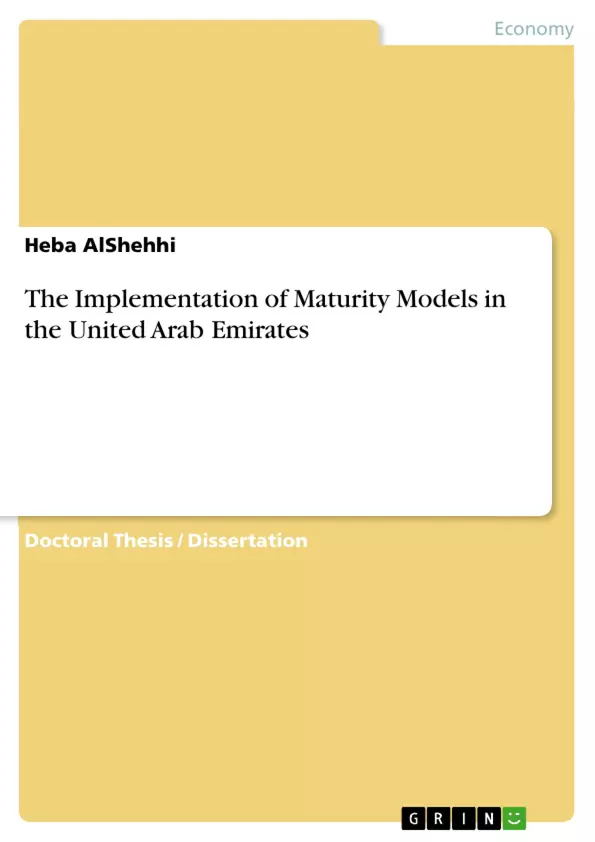The field of project management maturity has been introduced in the Middle East market recently and it is yet to prove its benefits. This research investigates the implementations of such maturity models in the UAE. The objective is to study and compare project management maturity models, show how they can be implemented in the UAE and finally recommend ways to merge different maturity models together to benefit from them the most.
The primary research method used in this research was to document a case study of an implementation of a maturity model in a government organization in Dubai, UAE. Moreover, experts' interviews were also means of primary research used for this research paper. In addition, the secondary research methods were represented by the academic online journals, electronic books and Dubai Municipality documents were used to collect data about maturity models. The dissertation concludes on the relevance and value of these models and provides recommendations for organizations seeking maturity models and recommendations for various project management audiences.
Inhaltsverzeichnis (Table of Contents)
- Chapter One: Introduction
- 1.1 Background....
- 1.2 Aim of the Research.
- 1.3 The objectives...
- 1.4 Structure of the research..
- 1.5 Methodology..
- Chapter Two: Review of the Literature
- 2.1 Project Management Offices (PMOs).
- 2.1.1 Definition of Project Management Offices (PMOs).
- 2.1.2 Roles of Project Management Offices (PMOs).
- 2.1.3 Types of Project Management Offices (PMOs)...
- 2.1.4 Responsibilities of Project Management Offices (PMOs)..
- 2.1.5 Relationship between Project Management Office and Project Performance
- 2.1.6 Relationship between PMOs and Project Management Maturity.
- 2.2 Background of Project Management Maturity Models..........\li>
- 2.2.1 Definition of Project Management Maturity Models...
- 2.2.2 Elements of Maturity Models: ...
- 2.3 Portfolio, Program and Project Management Maturity Model (P3M3).
- 2.4 Prince 2 maturity model........
- 2.5 The Berkeley Project Management Processes Maturity Model..
- 2.6 Project management process maturity (PM)2 model.
- 2.7 Capability Maturity Model (CMM)
- 2.7.1 Background of CMMs..
- 2.8 CMMI .....
- 2.8.1 Background of CMMI...
- 2.8.2 Structure of CMMI Product Suite.
- 2.8.3 Types of CMMI appraisals…......
- 2.9 Organizational Project Management Maturity Model (OPM3).
- 2.9.1 History of Organizational project management maturity model (OPM3)...
- 2.9.2 What is Organizational project management maturity model (OPM3) ..
- 2.9.3 Elements of Organizational project management maturity model (OPM3).
- 2.9.4 Structure of Organizational project management maturity model (OPM3).
- 2.9.5 Types of Organizational project management maturity model (OPM3) assessments.
- 2.10 Applying a mixture of Maturity Models (OPM3 and CMMI) ..
- 2.11 Comparison between OPM3 and CMMI
- 2.12 Case Study Background (Dubai Municipality).
- 2.12.1 Background about Dubai Municipality.
- 2.12.2 Background about Information Technology Department..
- 2.12.3 Background about Project Management in ITD.
- 2.12.4 Background about ITD – PMO
- 2.12.5 Reflection of Maturity Models in light of ITD – PMO.
- 2.13 Summary of Chapter ......
- Chapter Three: Research Methodology..
- 3.1 Introduction to Chapter.
- 3.2 Qualitative research approach.....
- 3.3 Methods of data collection.......
- 3.3.1 Primary Research
- 3.3.2 Secondary Research...........
- 3.3.3 Limitations of the research methodology:.
- Chapter Four: Analysis and Results
- 4.1 Case study 1 data:
- 4.1.1 ITD PMO-OPM3 assessment..
- 4.1.2 OPM3 Consultant recommendations to ITD PMO
- 4.2 Semi structured interviews
- 4.2.1 Expert Interview One- OPM3 certified assessor and practitioner (Lotfy Sabry, Managing Director, Experts Project Management Co.): .
- 4.2.2 Expert Interview Two- CMMI certified assessor and practitioner (P J Corum, Quality Assurance Institute Middle East FZ. LLC.):
- 4.3 Summary of chapter......
- Chapter Five: Discussion and Interpretation.
- 5.1 Summary of the main findings .....
- 5.1.1 Overall themes....
- 5.1.2 Case study.
- 5.1.3 Experts' interviews
- 5.2 Discussion of the Research Propositions.
- 5.3 Limitations of the empirical research conducted.
- 5.4 Suggestions for future research....
- Chapter Six: Recommendations..
- 6.1 Introduction:
- 6.2 Higher management in government or private organizations.
- 6.3 Heads of Project Management Offices .
- 6.4 Project Teams...
- 6.5 Maturity models implementers or assessors..
- 6.6 PMI and SEI...............
- 6.7 Academic researchers..
- Quote paper
- Heba AlShehhi (Author), 2011, The Implementation of Maturity Models in the United Arab Emirates, Munich, GRIN Verlag, https://www.grin.com/document/387681



